New York
About Andrew Cusack
 Writer, web designer, etc.; born in New York; educated in Argentina, Scotland, and South Africa; now based in London.
Writer, web designer, etc.; born in New York; educated in Argentina, Scotland, and South Africa; now based in London. read more
News
Blogs
Reviews & Periodicals
Arts & Design
World
France
Mitteleuropa
Knickerbockers
Argentina
The Levant
Africa
Cape of Good Hope
Netherlands
Scandinavia
Québec
India
Muscovy
Germany
Academica
A Dutch Organ in a Chelsea Church

THE ORGAN AT the Church of the Holy Apostles on Ninth Avenue in Chelsea has a brief history that spans three lands: the Netherlands, Texas, and New York. Mr. Joseph Mooibroek of Fairview, Texas was born in the Netherlands but emigrated to the United States in his youth and found his fortune there. Mr. Mooibroek (whose surname is Dutch for “beautiful trousers”) and his wife wanted an organ for the great hall of the castle they built in Texas, and appropriately he chose the Dutch firm of Van den Heuvel to construct the organ in 1994. Among Van den Heuvel’s other works are the organ at Saint-Eustache in Paris (1989, the largest organ in France), and that in the Duke’s Hall of the Royal Academy of Music in London (1993).
Allies Day, May 1917
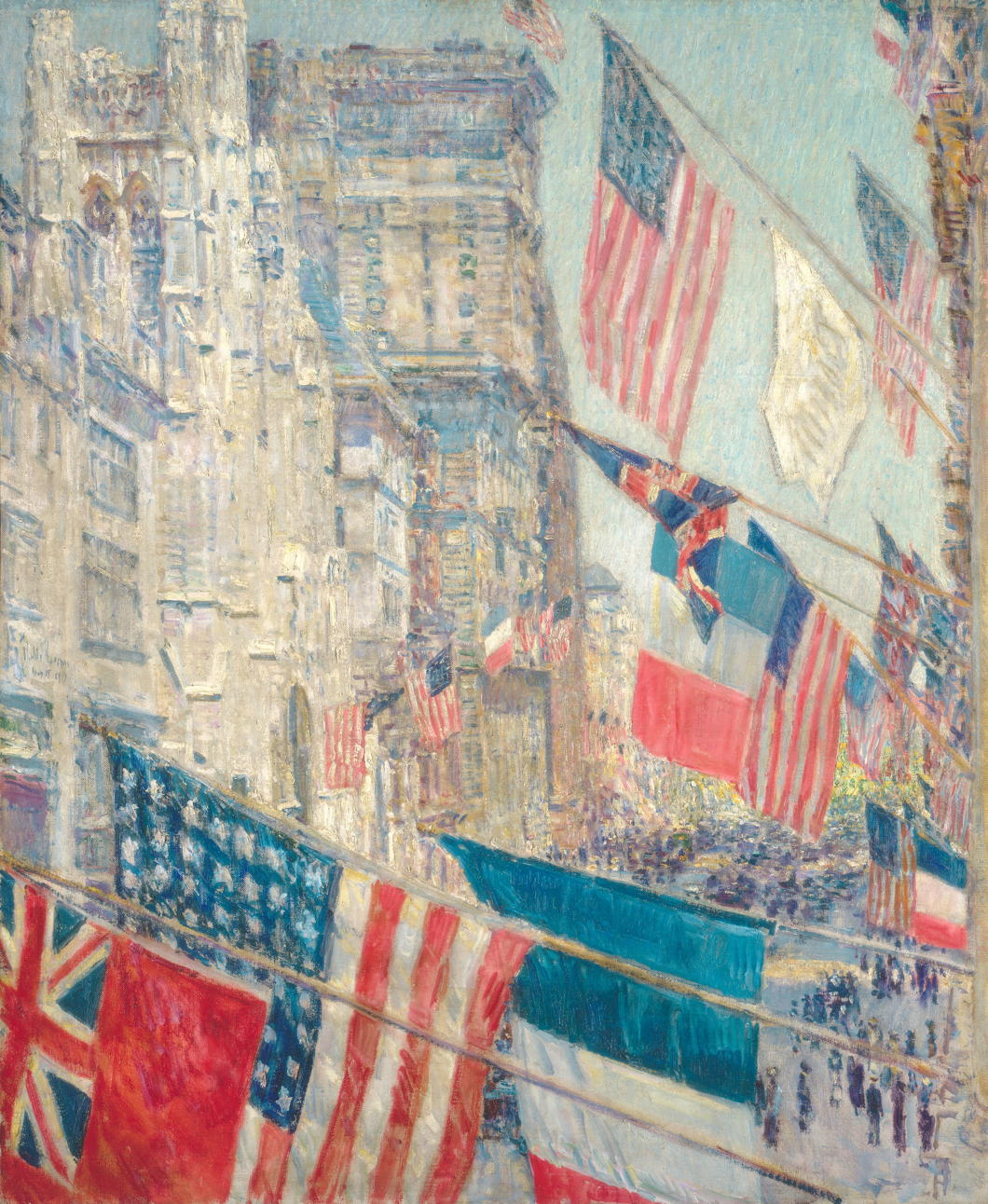
Childe Hassam, Allies Day, May 1917
Oil on canvas, 36½ in. x 30¼ in.
1917, National Gallery of Art (U.S.)
This has long been one of my favourite paintings, ever since I first saw it one day when I was very young while it was on loan to the Metropolitan. On a May day in 1917, Fifth Avenue was temporarily proclaimed “the Avenue of the Allies” and the British and French commissioners paraded down the boulevard with great ceremony. Childe Hassam set his easel on a balcony on the corner of Fifth Avenue and 52nd Street and took in the splendid scene towards the Church of St. Thomas and the University Club. Patriotic displays were much more lively then, involving bursts of flags and banners, than the rather dull and monotonous display of the single Stars-and-Stripes that became widespread after the World Trade Center attacks.
Interestingly, “Avenue of the Allies” aside, the United States was not actually allied to France and Great Britain during the First World War. President Wilson thought the United States was not so lowly as to merely intervene in a biased manner on the side of those it had lent money, but rather for the high-minded goal of establishing justice (or, as we might honestly call it, the destruction of Catholic Europe). The U.S., then, was merely a “co-belligerent” rather than an “ally”, though obviously this high-minded euphemism was lost on most people. During the Second World War, Finland found itself invaded by the Soviet Union and abandoned by the West, so — having no taste for Hitler and his Nazi charades — they became “co-belligerents” with Germany, rather than concluding a more distasteful alliance.
Hassam, who died in 1935, had little time for the avant-garde schools of art that came after the Impressionism he practised, and described modernist painters, critics, and art dealers as a cabal of “art boobys”. He was almost forgotten in the decades after his death, but the rising tide of interest in Impressionism from the 1970s onwards lifted even the boats of American Impressionists, and his Flags series of paintings are widely-known and much-loved today.
High Church Dutch Reformed
Not even the peaceful hills and dales of the Hudson Valley were left untouched by the liturgicalism of the Oxford Movement
SUCH WAS THE influence of the nineteenth-century “Oxford Movement” in the Church of England that it engulfed the great preponderance of the Anglican Communion. It is surprising when you consider that Anglican priests and even a bishop were jailed in England for such scandalous acts as calling the Communion service “the Mass”, wearing vestments, and putting candles on the altar; these are now so widespread in the Church of England to be commonplace. But the Oxford movement also spilled out into other Protestant groups as well. The liturgical movement changed the Church of Scotland in the 1900s, and many of the Kirk’s medieval church buildings that had been converted into pulpit-centered preaching halls were reordered in a way emphasizing the “Communion table” that was an altar in all but name. (Those who can find before & after shots of the ‘Toon Kirk’ of Holy Trinity in St Andrews, Fife will notice this marked contrast).
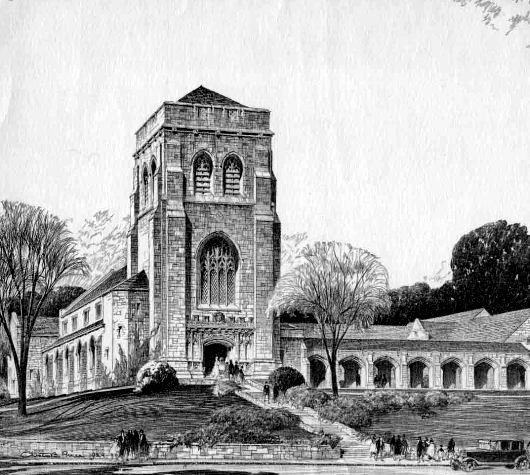
Old Guard Ball, 1949
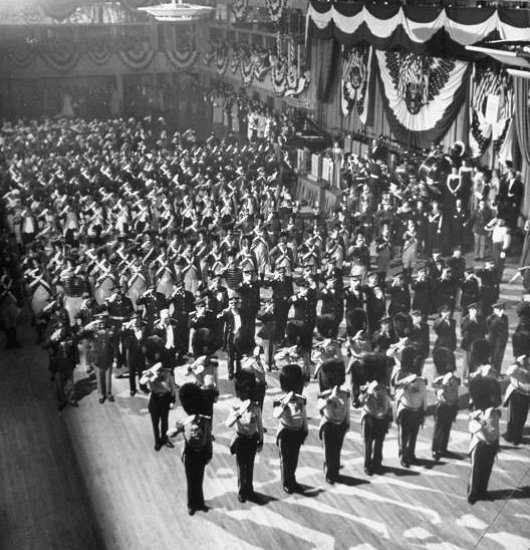
The Annual Ball of the Old Guard of the City of New York, Commodore Hotel, 1949.
200 Years was an Empty Anniversary for New York’s ‘Gallant Seventh’
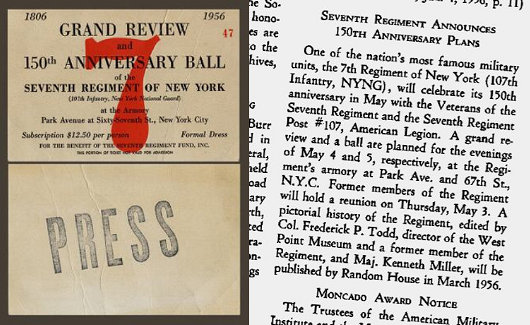
Flipping through a military journal from early 1956, I stumbled upon a rather depressing note announcing the Seventh Regiment’s plans for celebrating its 150th anniversary. A reunion of old comrades on Thursday May 3, then a grand review the following day, and topped off by a formal ball on the evening of Saturday May 5 at the regiment’s beautiful armory on Park Avenue at 67th Street.
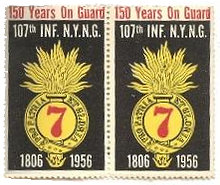 Why should such a splendid celebration spark dour thoughts? Chiefly because, having survived over a century and a half since the unit was founded amidst pints of ale in the Shakespeare Tavern on the corner of Nassau and Fulton, the Seventh Regiment was abolished before it could celebrate its 200th anniversary in 2006. The Seventh was deactivated as a regiment in 1993, though its “lineage” was transferred to the 107th Corps Support Group, which in 2006 was “consolidated” into the 53rd Army Liaison Team. The regiment’s unique collection of historical artifacts — the legal property of the Veterans of the Seventh Regiment — was seized by the State in an act of highly dubious constitutionality and its armory, built without a cent of public money from the pockets of the regiment’s members in the 1880s, was also taken and transferred to a conservancy to run it as an events & performing arts venue, over protests from both veterans groups and the local community.
Why should such a splendid celebration spark dour thoughts? Chiefly because, having survived over a century and a half since the unit was founded amidst pints of ale in the Shakespeare Tavern on the corner of Nassau and Fulton, the Seventh Regiment was abolished before it could celebrate its 200th anniversary in 2006. The Seventh was deactivated as a regiment in 1993, though its “lineage” was transferred to the 107th Corps Support Group, which in 2006 was “consolidated” into the 53rd Army Liaison Team. The regiment’s unique collection of historical artifacts — the legal property of the Veterans of the Seventh Regiment — was seized by the State in an act of highly dubious constitutionality and its armory, built without a cent of public money from the pockets of the regiment’s members in the 1880s, was also taken and transferred to a conservancy to run it as an events & performing arts venue, over protests from both veterans groups and the local community.
Meet the new boss
The Pope sends New York a genial, beer-swilling man of an archbishop
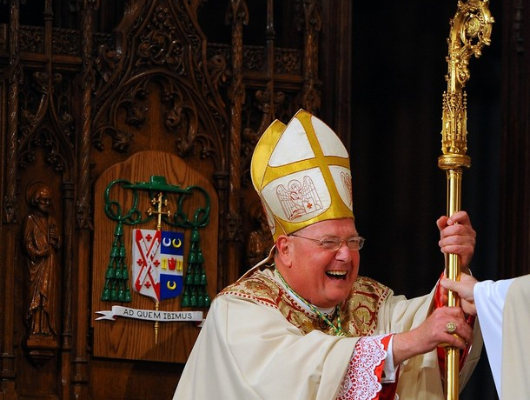
The Most Rev. Timothy Michael Dolan, the newly installed Archbishop of New York, has a reputation as a genial beer-swilling giant that will doubtless serve him well as he takes possession of his new see. With a Ph.D. in Church History, Archbishop Dolan formerly served as Secretary to the Nuncio in Washington, D.C. before becoming Rector of the Pontifical North American College in Rome — the “West Point” of the Catholic Church in Anglo-America. Having improved the NAC’s reputation both in studies and in orthodoxy, Msgr. Dolan was then sent by the Holy Father to be an Auxiliary Bishop in the Archdiocese of St. Louis. From there, our man was given the charge of see himself, that of Milwaukee.
The Arms of the Archbishop
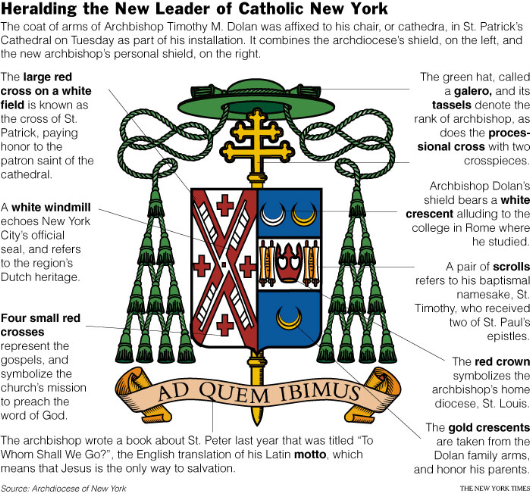
The New York Times offered a little sidebar on the heraldry of our new ecclesiastical boss in its coverage of Archbishop Dolan’s installation, and Fr. Selvester offers his commentary as well.
The Irving Dinner
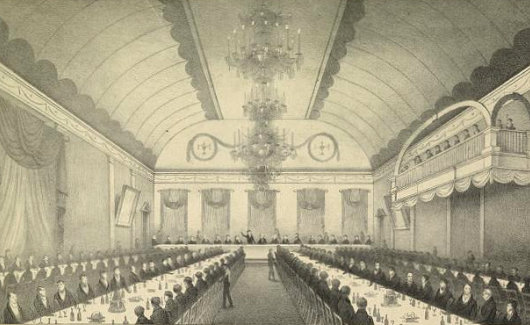
It was slightly remiss of us to neglect commemoration of the two-hundred-and-twenty-sixth anniversary of that genius of the Knickerbockers, Washington Irving. “Diedrich Knickerbocker,” “Jonathan Oldstyle,” “Geoffrey Crayon,” or, as he was baptized, just plain Washington Irving was born on April 3, 1783, exactly five months before the Treaty of Paris established the legal independence of his home state of New York and the twelve other former colonies along the Atlantic coast.
Irving was arguably the first American celebrity, and deservedly so. After a seventeen-year exile in England, France, Germany, and Spain, the author returned to New York in 1832, and a celebratory dinner was held in his honor at the City Hotel in New York on the evening of May 30. He is seen in this contemporary picture addressing those who assembled to render him honor, many of them from among the city’s political, cultural, and social elites. Indeed, the Saint Nicholas Society was founded just three years later for the preservation of the Dutch history and customs of New York, a noble task in which it continues to this day.
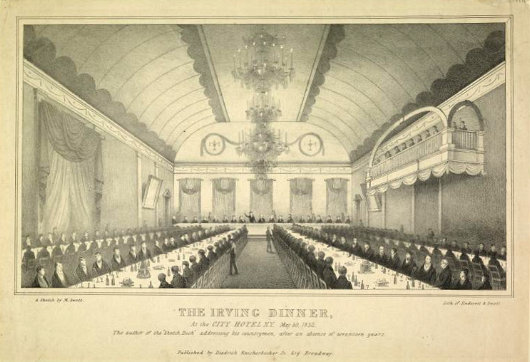
Paris Arts & American Arms
Maj. T. L. Johnson’s Cartographic Mural on Governors Island
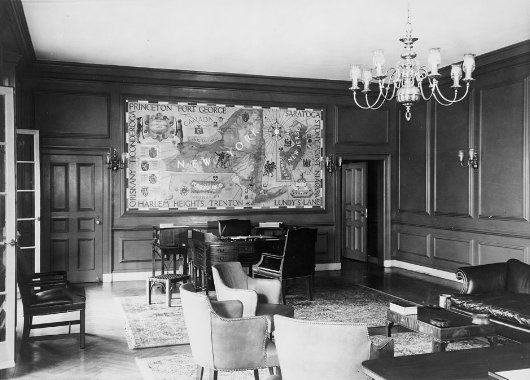
One of the best aspects of the inter-war construction of Governors Island is that the refinement of McKim Mead & White’s architecture is matched inside by a series of interior murals painted under the auspices of the WPA. These murals often veered towards the refreshingly jocular, as can be seen in the War of 1812 mural in Pershing Hall (a corner of which is captured here by photographer Andrew Moore). The mural by Major Tom Loftin Johnson (educated at the Ecole des Beaux-Arts in Paris) depicted here, however, is a map of the area under the purview of the Second Corps, U.S. Army headquartered at Governors Island; namely the states of New York, New Jersey, and Delaware, and the then-territory of Puerto Rico.
A new bookplate for the NYG&B
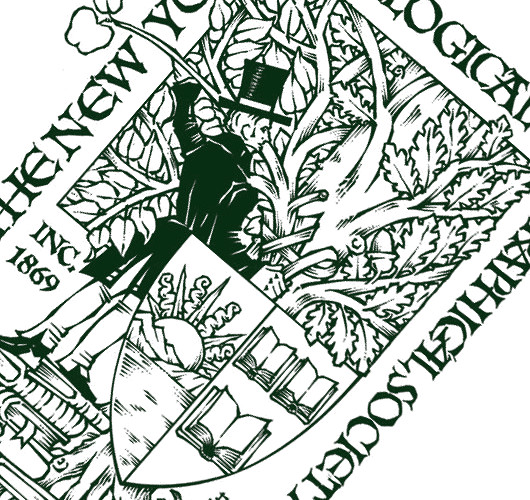
Fr. Guy Selvester reports on his resurrected Shouts in the Piazza blog that the great Marco Foppoli has designed a new bookplate for the New York Genealogical & Biographical Society. Mr. Foppoli is the most highly-regarded heraldic artist of our day, and the influence of the style of his mentor, the late Archbishop Bruno Heim, is apparent in his work.
Eric Seddon on Washington Irving
Alongside Miklos Banffy, Washington Irving is probably my favourite author. I have two sets of his complete works, and will obtain at least a third — my favourite printing of the complete Irving, in an excellent handy size — when I can find it for the right price. It is curious, but by no means suprising, that Irving’s genius is nearly forgotten today even though he was the first American to be an international superstar, famed on both sides of the Atlantic. He is mostly known only through his authorship of Rip van Winkel and The Legend of Sleepy Hollow, both of which works are rarely presented in their original written form, but almost always in shortened illustrated versions for schoolchildren from publishers convinced of their audience’s stupidity.
Irving is rarely in the limelight these days, but First Things Online recently published an informative article, “Washington Irving and the Specter of Cultural Continuity” by one Eric Seddon, that is well worth reading.
His first book, Dietrich Knickerbocker’s History of New York, capitalized on the amnesia of New Yorkers by a mix of biting satire and real history of the Dutch reign in Manhattan. The book is foundational to any study in American humor. It is wild, free, self-deprecatory, and merciless to the public figures of his day, and by turns lyrically funny, absurd, and reflective. Without it, we might wonder whether American humor, from Twain to the Marx brothers to Seinfeld, would have taken the particular shape it did.
When Americans, always prone to utopian daydreams, were in danger of taking themselves far too seriously, when the term “manifest destiny” was embryonic, Dietrich Knickerbocker rolled his bugged-out eyes, chuckled gruffly, and whispered into the ear of a young nation, “Remember thou art mortal.” […]
Irving’s two most famous stories are to be found in The Sketch Book, virtually bookending the text: “Rip Van Winkle” and “The Legend of Sleepy Hollow.” In “Rip Van Winkle,” Irving whimsically pointed out the hazards of the new Republic, that a once humble acceptance of life under monarchy could easily give way to arrogant corruption, vice, and the nauseating specter of being governed by village idiots with a gift for demagoguery. […]
The final warning of the book comes in the form of a Headless Horseman, who is either a real ghost of the Revolution or the town bully in disguise, and who targets, of all people, the schoolmaster (even small towns have their intelligentsia). Is it history chasing Icabod Crane, the puritanical teacher obsessed with stories of witch hunts, or just Brom Bones scaring him out of town? Irving doesn’t say, and perhaps our answers tell more about ourselves than about him.
Washington Irving spent his last days in Tarrytown, near the setting of his most famous story. He was a member of the local Episcopal Church, tried to revive the old Dutch festivities on St. Nicholas Day, and was moved to tears by singing the Gloria. In particular he loved to repeat the words “Glory to God in the highest, and on earth peace, and good-will to men.” Though his era was in many ways a bigoted one, he resisted and thereby helped to shape a better future. One of his last revisions to Knickerbocker came late, removing the anti-Catholic references its youthful version contained. He was a man who had seen his share of specters, to be sure, but who didn’t believe they were the strongest reality.
The Finest Library in All New York
Or is it in all the New World?
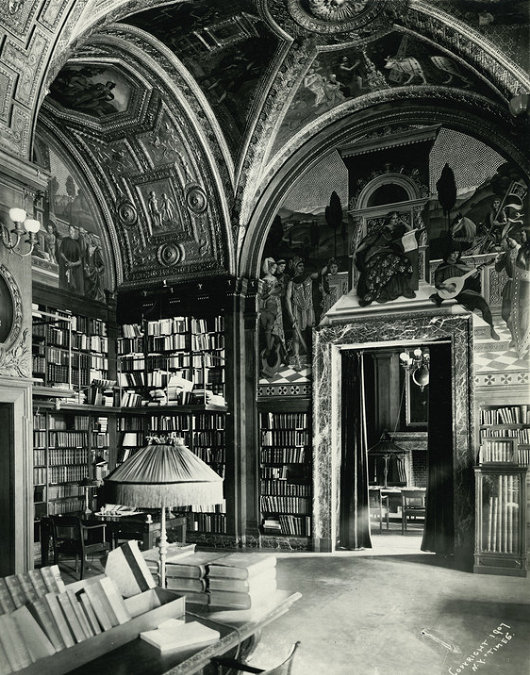
I do miss my two libraries in Manhattan, the Society Library on 79th Street and the Haskell Library at the French Institute on 60th. Neither of them, however, are fit to shine the boots of the library of the University Club on 54th & Fifth. Architecturally and artistically, it is undoubtedly the finest library in New York. But does it have an equal or a better in all the New World? The BN in BA certainly isn’t a competitor.
West End Collegiate Church
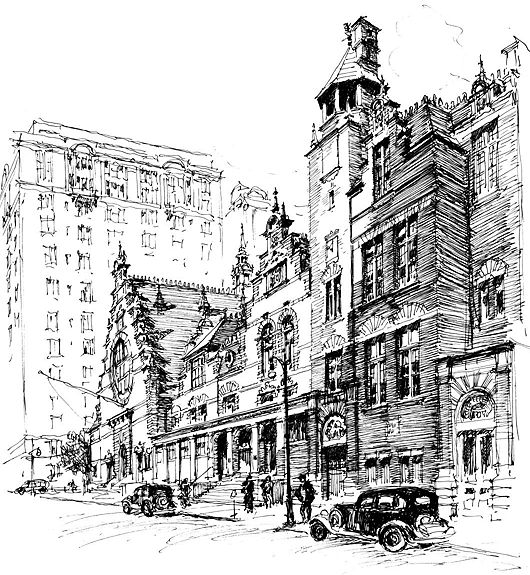
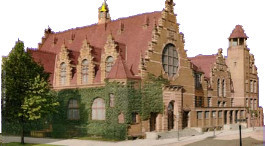 One of my good friends, who is amongst the most loyal denizens of this little corner of the web, found our post on St. Nicholas Collegiate Church of great interest because his son attended the Collegiate School, the oldest school in North America (founded in 1628, and formally incorporated ten years later). The Collegiate School is part of the same complex as the West End Collegiate Church on the corner of West End Avenue & 77th Street on the Upper West Side. The church & school buildings were designed by McKim Mead & White in a Dutch Renaissance Revival style, and handsomely executed.
One of my good friends, who is amongst the most loyal denizens of this little corner of the web, found our post on St. Nicholas Collegiate Church of great interest because his son attended the Collegiate School, the oldest school in North America (founded in 1628, and formally incorporated ten years later). The Collegiate School is part of the same complex as the West End Collegiate Church on the corner of West End Avenue & 77th Street on the Upper West Side. The church & school buildings were designed by McKim Mead & White in a Dutch Renaissance Revival style, and handsomely executed.
THE ARCHITECTS modelled the church after the seventeenth-century Vleeshal (meat market) of Haarlem in the Netherlands. The story goes that, during the Second World War, a handful of Collegiate grads serving together in the U.S. Army participated in the liberation of Haarlem, stumbled upon the Vleeshal and said “Hey, that’s our school!”
The Dering Roll
College of Arms Foundation
&
The
Committee on Heraldry
of the
New York Genealogical & Biographical Society
cordially invite you to a talk by
MARIA DERING
on
THE DERING ROLL
Wednesday 14 January 2009
at
6:00 PM
The Portrait Gallery
No. 122 East 58th Street
Between Park & Lexington Avenues
In August 2008, the British Library acquired ownership of the Dering Roll, the oldest-surviving English roll of arms. The illuminated parchment dates from c. 1270-1280 and is a vital documentary record for the study of knighthood in medieval England. It contains 324 coats of arms arranged in 54 rows, with six shields assigned to each line.
Maria Dering, a member of the G&B’s Committee on Heraldry, will present an illustrated talk about the Dering Roll, its history, and the public campaign to keep it in the United Kingdom after it was bought by a foreign collector.
Admission charge of $20 (cash or check) includes a wine and cheese reception.
To reserve, please email John Shannon at john.shannon@coaf.us.
New York’s Dutch Cathedral
The Collegiate Church of St. Nicholas, Fifth Avenue
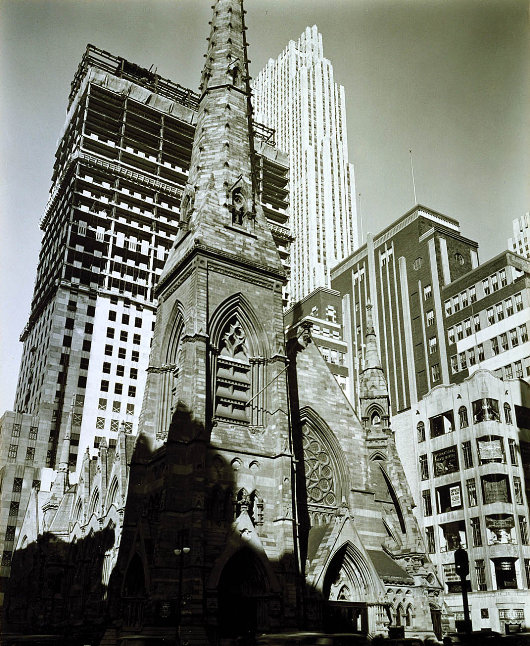
Dedicated a hundred-and-thirty-six years ago, the Collegiate Reformed Protestant Dutch Church of Saint Nicholas on the corner of Forty-eight Street & Fifth Avenue (photographed above by Berenice Abbott) was for many years regarded as the most eminent Protestant church in New York. The Collegiate Reformed Protestant Dutch Church is the oldest corporate body in what is now the United States, having been founded at the bottom of Manhattan in 1628 and receiving its royal charter from William & Mary in 1696. Now part of the Reformed Church of America, the Collegiate Reformed Protestant Dutch Church is actually a denomination within a denomination, and the remaining Collegiate Churches of New York tend to preach a sort of “Christianity Lite”. (The famous Norman Vincent Peale, author of The Power of Positive Thinking and one of the paragons of the “finding a religion that doesn’t interfere with your lifestyle” school of thought, was the pastor of Marble Collegiate Church at Twenty-ninth & Fifth, where Donald Trump is a member of the congregation).
Peter Stuyvesant’s Legion
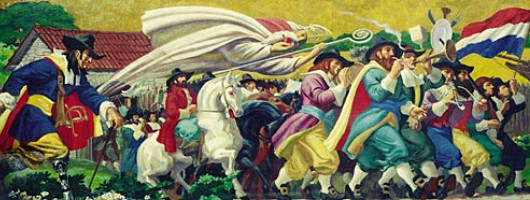
Oil on canvas, 30 in. x 80 in.
1953, Jacob Ruppert Brewery
An Aside: I was taught Latin beside the beautiful carved marble fireplace in the artist’s dining room. Winter lived next door to the school, which purchased the house after his death and used it for class rooms. In our more neglectful hours which investigated the basement, in which were still secreted some of the artist’s sketches for larger murals and models for a bas-relief.
Remembering the Seventh
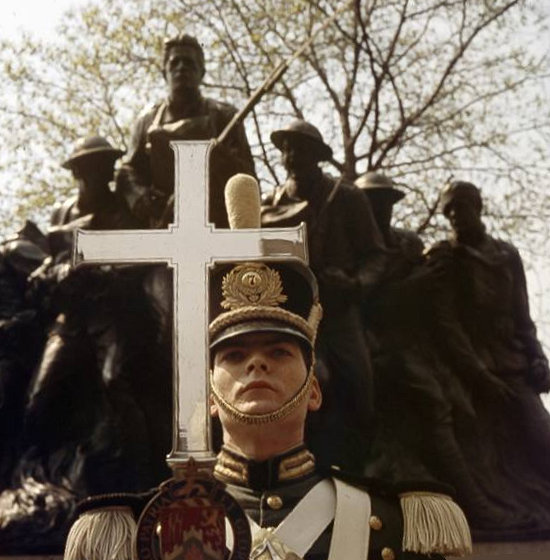
It is entirely appropriate that November 11 — Armistice Day — both falls during the month of the Holy Souls and on the feast of St. Martin of Tours. It’s not unlikely that the souls in Purgatory added their voices to plead for peace that November of 1918, and St. Martin, who had himself been a Roman soldier, was no doubt leading the cause from Heaven. (Indeed, his father having been in the Imperial Horse Guards, St. Martin was born into a military family).
67th & Fifth
One of the most remarkable things about these photos from a 1956 Seventh Regiment ceremony are how traditional the buildings in the background are.
Diary
Nothing ever happens in New York, or at least nothing when compared to Edinburgh, London, or Paris; this is my perpetual complaint. But when it rains, it pours, and so it was last night. Not only was it press day, the busiest day of the month-long cycle of creating each issue of The New Criterion, but then the evening beheld both “A Festive Evening Celebrating the Mission of the von Hildebrand Project” at the University Club and “The Reception and Dinner to Present the Medal for Heraldic Achievement” at the Racquet & Tennis Club. The simultaneous events were organized by the Dietrich von Hildebrand Legacy Project and the Committee on Heraldry of the New York Genealogical & Biographical Society, respectively.
A rarely-assembled fun crowd was promised at the von Hildebrand event, but nor was the presentation of the G&B’s medal a common occurrence (there have been only three awarded to date) so I simply resolved that I would do my best to attend both. (more…)
The New York Central Building
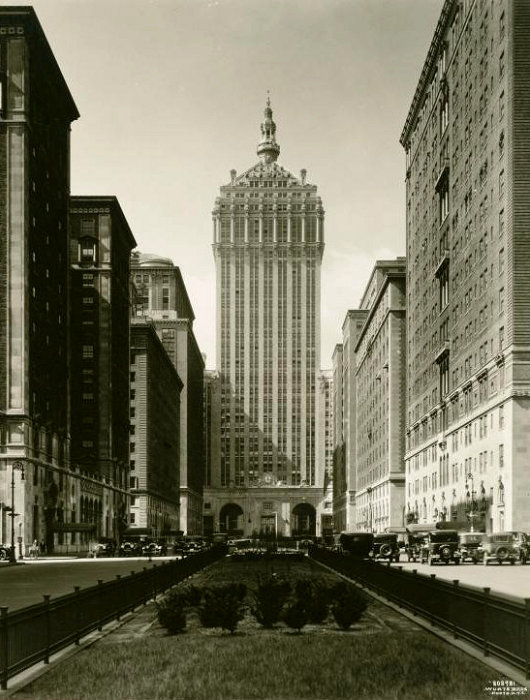
The New York Central building once presided majestically over an equally elegant Park Avenue, which is cleverly directed through the building from the south, emerging through the double arches on the north side. Sadly, while the tower (now known as the Helmsley Building) still stands, the view of it has been marred since 1963 when the Pan Am building was built between it and Grand Central Terminal. When it opened, the Pan Am building was the largest commercial office building in the world, and it was certainly one of the least graceful. The 1960s and 70s were not kind to Park Avenue on either side of Grand Central, and many of the traditional-style buildings have been demolished or re-clad in glass.
Search
Instagram: @andcusack
Click here for my Instagram photos.Most Recent Posts
- Faithful Shepherd of the Falklands April 8, 2025
- Articles of Note: 8 April 2025 April 8, 2025
- Proportionality Destroys Representation April 8, 2025
- Sag Harbor Cinema March 26, 2025
- Teutonic Takeover March 10, 2025
Most Recent Comments
Book Wishlist
Monthly Archives
Categories


